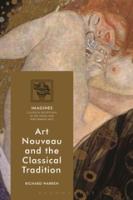
Bloomsbury (2018) h/b 217pp £85 (ISBN 9781474298551)
Art Nouveau and Classics might, at first sight, appear to be a paradoxical pairing, but there are commonly reproduced images, such as Klimt’s Danae which adorns the cover of this volume, that are indicative of a strong influence of the ancient world on the ‘new art’ of this late 19thbC movement. Perhaps the style of the applied arts with their flowing natural forms is what we immediately recognise as Art Nouveau, but, as this book so richly demonstrates, there is more to this ‘movement’ than Lalique glass or Tiffany lampshades. Indeed, such is the diversity of Art Nouveau that this book can only offer a broad selection of representative examples. W. does indicate that Classical art is far from the dominant influence. Japanese art has that claim, along with (in no particular order) Celtic, Islamic, Gothic, Baroque, Rococo. But W. intends the book to act as a corrective to the idea that Art Nouveau is based on a rejection of the Classical. For while the impulse to ‘make it new’ leads to rich and varied transformations of the Classical, there is also a strong engagement with the original. The boundaries between artistic movements are not always easy to define, and in this volume Symbolism and Art Nouveau in particular are sometimes difficult to distinguish. On Fernand Khnopff’s I Lock My Door upon Myself W. explicitly confesses it is ‘more a Symbolist than an Art Nouveau work, but worth considering’ because it relates to the theme of death (and it contains a depiction of the head of Hypnos in the British Museum).
Despite the restrictions of space W. has brought together an impressive array of Classical influences. Between his introduction and conclusion there are seven chapters arranged by theme (Re-birth, Muse, Hero, Bloom, Desire, Nation, Death) in each of which works by artists from a number of principally European countries are picked out for their re-cycling of classical material. Influence can be observed in stylistic features: Beardsley’s two-tone drawings with his penchant for profile seems to retain an echo Greek vase painting; Prague’s main railway station has a frieze with metopes, triglyphs, regulae and guttae (transformed, but still clearly recognisable).
But it is the subject matter that is most obviously re-used. Some is derived from drama, for example Mucha’s well-known poster for Sarah Bernhardt’s Medea, Beardsley’s notorious illustrations for Lysistrata or the Czech artist František Kupka’s Prometheus Bound. Some, though not so much, is derived from epic, such as the Polish artist and playwright Wyspiański’s illustrations for the Iliad. Much is derived from mythology in general, such as the inevitable gorgons and sirens, Beardsley’s Apollo Pursuing Daphne or depictions of Orpheus by Ferenc Helbing and Franz von Stuck.
There is an occasional slip, as when W. attributes some details to the wrong painting when describing two representations of Athena by Klimt and Franz von Stuck. A reference to the Secession building in Vienna having ‘no sculptured architrave or pediment’ confuses the unadorned architrave of the classical orders with the sculptured frieze. These, however, are rare slips in a book which is clearly written and packed with information about a wide range of art. It contains 36 b/w illustrations, but this is nowhere near enough to accompany the works mentioned in the text. Fortunately there is a note at the end of the list of illustrations which directs the reader to the book’s page at Bloomsbury.com where there are links to most of the illustrations on line:
https://media.bloomsbury.com/rep/files/art-nouveau-and-the-classical-tradition-online-links.pdf
Alan Beale
